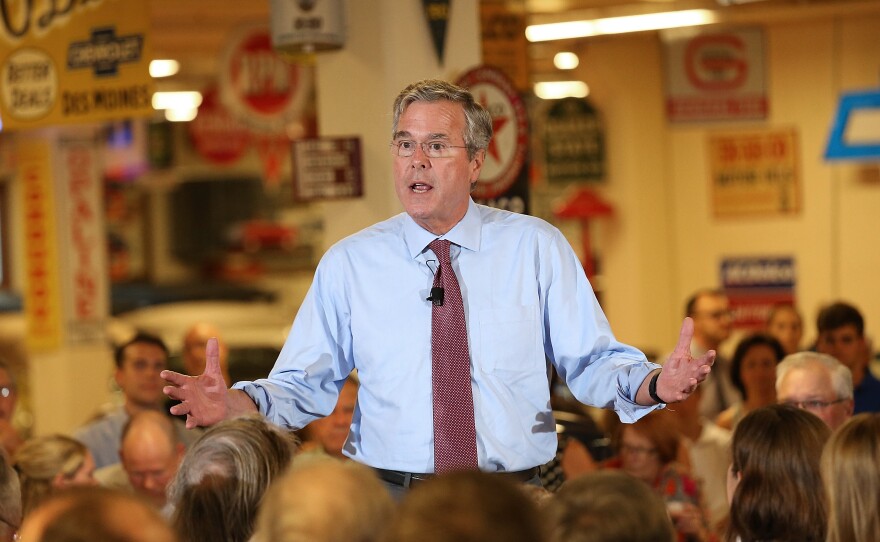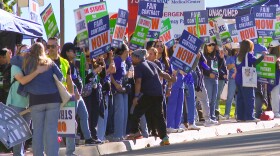Jeb Bush's tax plan tries to do a lot. The plan aims to lower the highest tax rate, offer some relief to low earners, reform corporate taxes, stick it to hedge-fund managers and also, by the way, "unleash 4 percent growth" in the economy, as the former Florida governor puts it.
In a Wednesday op-ed in the Wall Street Journal, Bush outlined his plan. It contains a lot of Republican tax-reform standbys — fewer brackets, fewer loopholes, lower corporate rates — along with a couple of surprises, like closing a loophole that allows some Wall Street types to pay lower taxes. And all of it comes packaged in Bush's campaign-trail promise that he can grow the economy by 4 percent.
Here's a look at the plan, as well as a dive into whether it could really boost growth that much.
What's in the plan?
Before we dive into the plan's effects, here's a quick rundown of the big things Bush's tax plan would do.
- Reduce number of individual income tax brackets from the current seven, ranging from 10 to 39.6 percent, to three — 10, 25, and 28 percent
- Cut the top corporate tax rate to 20 percent, from 35 percent, and also change it to a territorial tax system
- Cap the total value of tax deductions (like the mortgage interest or medical deduction, for example) at 2 percent of a filer's adjusted gross income
- Nearly double the size of the standard deduction
- Double the earned income tax credit for childless workers
- Eliminate the carried-interest loophole, a provision that allows some fund managers to claim their income as capital gains, giving them a lower rate
Who would benefit?
Several of the provisions are clearly intended to entice lower- and middle-income Americans, who have taken center stage in an election focused on the plight of the middle class. The Bush campaign estimates that 15 million more families would pay zero income taxes. On top of the current 66 million, that would bring the share of filers paying zero taxes from around 40 to nearly 50 percent.
The plan would either lower or hold the marginal rates at every income level from where they are now.
But then, the plan would also eliminate some deductions and cap the amount that people can deduct, which would offset some of those rate reductions. For example, Bush would eliminate the state and local income tax deduction, which overwhelmingly benefits higher earners, and cap the amount of deductions a filer can take, which also would affect higher earners more.
So the question of whether a high-income household would see a higher or lower tax burden in part depends upon the amount of deductions they take.
Interestingly, that could mean more pain for blue states. The highest-tax states in the nation include Democrat strongholds like New York, New Jersey, and California. Meanwhile, several red states like Wyoming, Texas, and South Dakota have no state income tax. Eliminating the deduction would mean a higher bill for the higher earners in blue states.
There's also plenty for businesses to like. The plan would cut the corporate rate from 35 to 20 percent and change the U.S. system from a worldwide to a territorial system — that is, it would start only taxing businesses on earnings they make in the US. Business groups like the Chamber of Commerce have long pushed for this kind of a system, claiming it would make the US more competitive.
But how expensive is it?
This is one of the most important questions about the plan, and one for which we don't have an answer yet — the Bush campaign hasn't revealed estimates of whether his plan is revenue-neutral or not, nor have any major tax policy think tanks.
But it sure looks like it could be expensive. It's true that the plan has a couple of ways to raise revenue: eliminating loopholes, limiting deductions, and raising taxes on carried interest.
That said, the plan also has a lot of ways it would cut tax revenue — cutting the top marginal rate from 35 to 28 percent, for example. (The plan doesn't specify where the bracket cutoffs are, but in creating three brackets at 10, 25, and 28 percent, plenty of people in the middle and bottom would also presumably have lower tax rates as well.)
Not only that, but it would lower the corporate tax rate to 25 percent. And, perhaps most notably, it could create millions more earners who pay zero in income taxes. Bush writes that "roughly 15 million Americans will no longer bear any income-tax liability," though it's not entirely clear that that's 15 million in addition to the roughly 66 million who have zero or negative income taxes right now.
We don't know specifics on many of these things yet, but it's possible that the tax plan could have some lost-revenue ground to make up. Often, advocates of cutting taxes claim that a boost in economic growth will itself raise revenues.
For that reason, one huge question that still hangs in the balance about Bush's plan is how much revenue it will lose from tax cuts — or how much economists will estimate it could spur economic growth.
But can it grow the economy?
This is the big question, given the potential effects on revenue. A few provisions in the plan do look good for economic growth. Bush plans to expand the earned income tax credit, for example, and there's good evidence that the EITC incentivizes work, boosting labor force participation.
Nudging more people into the workforce could be great at a time when the labor force participation rate (that is, the share of working-age adults working or looking for work) has stagnated. (However, economists differ on exactly how much the recent decline in the rate is due to an aging workforce entering retirement, as opposed to a persistently weak job market.)
In addition, Bush would allow businesses to "fully and immediately deduct new capital investments," an idea that Republican tax plans have pushed for years.
"Immediate expensing is a big deal," says Michael Strain, resident scholar at the American Enterprise Institute. And the effects of it could go well beyond simple business investment. "The idea is that incentivizing investment will lead to more investment, which will make workers more productive, which in turn will increase their wages."
In other words, your bosses invest in better machinery and you can get more done, meaning you're more valuable and worth a raise.
But even if you believe a president can create sustained 4-percent growth (which is already a huge, dubious assumption), it's not at all clear that reforming the income tax code itself can grow the economy much.
"The record on tax cuts and growth is just weak," says William Gale, an expert on tax policy at the Brookings Institution. He says economic growth has remained remarkably stable over the years, when you consider the massive changes in the tax code that have also happened. Some tax increases have been associated with faster growth, and some tax cuts have likewise come alongside slower growth.
"It's not that taxes have no effect, it's that other things affect the economy," he says. "We tend to focus on taxes because it's something we can control. But the evidence that we can flip the switch on tax policy and it creates growth is not there."
A 2012 Congressional Research Service paper, for example, found that the top tax rate doesn't seem to have an effect on economic growth. Likewise, in a fall 2014 paper, Gale and former George W. Bush economic advisor Andrew Samwick found that tax cuts themselves don't seem to create higher growth.
Rather, they concluded, growth comes from carefully calibrated fiscal policy — in particular, tax cuts can't be paid for with more government borrowing (which can lower long-term growth). Instead, they need to come alongside spending cuts...and even then, only "unproductive" spending should be cut. Cutting productive programs, like those that help people get educated or get basic needs like food, says Gale, could do more harm than good.
How does it compare to other tax plans?
Bush's tax plan is a very Republican tax plan, with a lot of the standard Republican ideas. Indeed, it looks an awful lot like Mitt Romney's 2012 tax plan, as the Washington Post's Jim Tankersley points out.
It has some similarities to his GOP opponents' plans as well — it reduces the number of brackets, for example. Chris Christie, like Bush, would create three brackets, and Marco Rubio would create two. It expands deductions to help lower- and middle-income earners, like Rubio's plan. It lowers the corporate rate and shifts the corporate system to a territorial system — a longtime GOP talking point.
But it also contains one notable populist touch: an end to the carried-interest loophole, which allows some fund managers pay lower taxes on their income by claiming it as capital gains. Donald Trump has likewise talked about doing this to raise taxes on "hedge fund guys," and both Hillary Clinton and President Obama have pushed for it in the past.
Perhaps most surprising in the plan is that idea of growing the number of people who owe zero in taxes. If indeed Bush adds 15 million tax filers to that group, it's a clear attempt to distance himself from one of Romney's biggest mistakes in the 2012 campaign.
A video of Romney decrying the "47 percent" of Americans who pay zero income taxes proved incredibly damaging to his run, making him look callous by implying that nearly half of the US doesn't contribute (which is entirely untrue). Bush clearly wants to avoid being painted with the same brush. The question is whether his plan is sustainable.
Copyright 2015 NPR. To see more, visit http://www.npr.org/.






